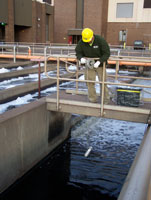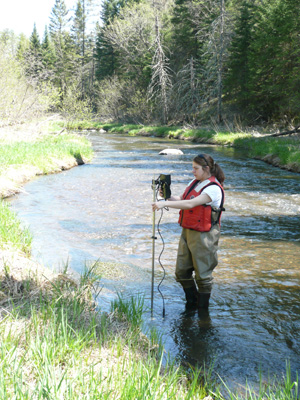Minnesota Water Science Center

Endocrine Active Chemicals/Wastewater Treatment PlantMinnesota PROJECTSABOUT THE MINNESOTA
|
QUALITY-ASSURANCE (QA) PLAN  A quality-assurance plan has been established to evaluate laboratory and field sampling techniques, to assess possible sources of contamination, and to assure representative samples. All field personnel were familiarized with study design and sampling protocols prior to field sampling or data processing to assure sample integrity. Laboratory quality-control samples were used to validate analytical data. Field quality-assurance samples were used to assess sample collection and processing. Laboratory quality-control samples include laboratory blanks, reagent spikes, and surrogates. At least one fortified laboratory spike and at least one laboratory blank were analyzed with each set of 10–16 field samples. Laboratory reagent blanks were used to assess potential sample contamination. Recoveries for compounds spiked into reagent water, and surrogate compounds in field samples indicate the general proficiency of the laboratory methods. Most methods will have surrogate compounds added to samples prior to extraction to monitor method performance. Surrogates are chemicals that have similar properties to the analytes of interest, but do not interfere with quantitation of the compounds of interest. Potential contamination of water samples because of collection and sample processing was assessed with field-blank samples. Field blanks were prepared at the selected site prior to, or following, a scheduled field sample. Blank samples were prepared by processing HPLC grade organic-free water (Baker Analyzed, J.T. Baker Co.) through the same equipment used to collect and process field samples. Approximately 4 blank samples were collected and analyzed to assess contamination introduced during sample collection and processing for water samples. Replicate samples are used determine variability of detection and concentration that result from sample processing techniques (sample splitting, filtration, and transport). Replicate samples consist of a split of the field sample so the field and replicate samples should be nearly equal in composition. Replicate water and bottom sediment samples were collected at 4 sites. All collection and processing equipment was cleaned between samples with a succession of native water, soapy tap water, tap water, deionized water, methanol, and organic-free water rinses. To avoid contamination of samples, use of personal care items (such as insect repellent, sunscreen, cologne, aftershave, and perfume) was avoided for personnel collecting and processing samples. Caffeinated products and tobacco products will not be consumed during (or immediately prior to) collection or processing of samples. Powderless, disposable gloves were worn during bottom-sediment sample collection to avoid contamination of samples.
|